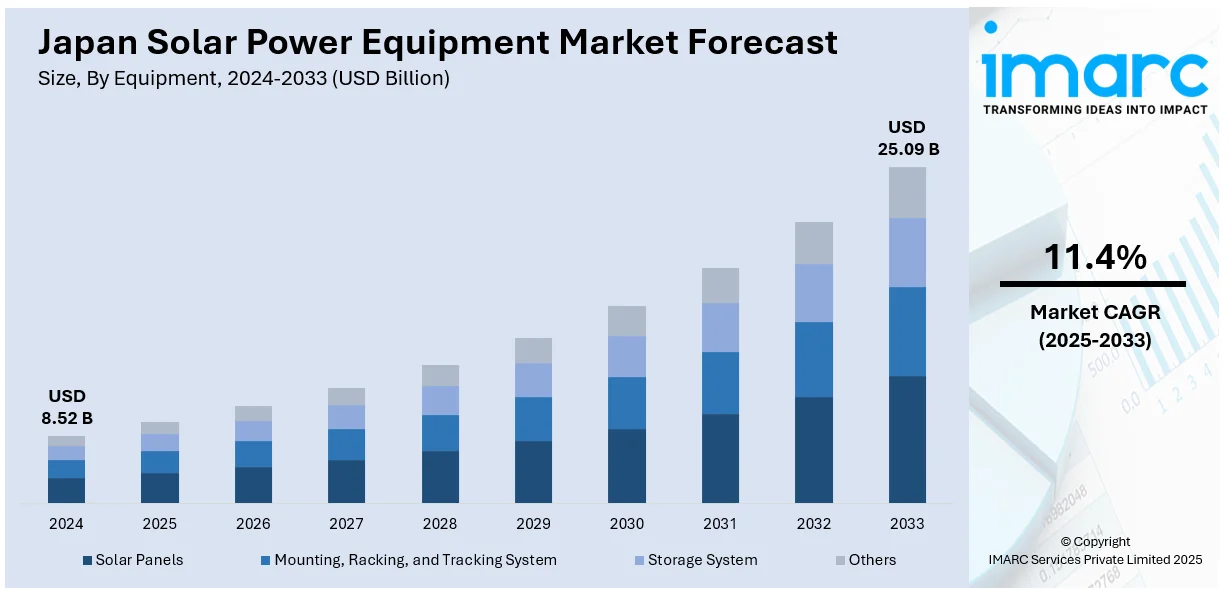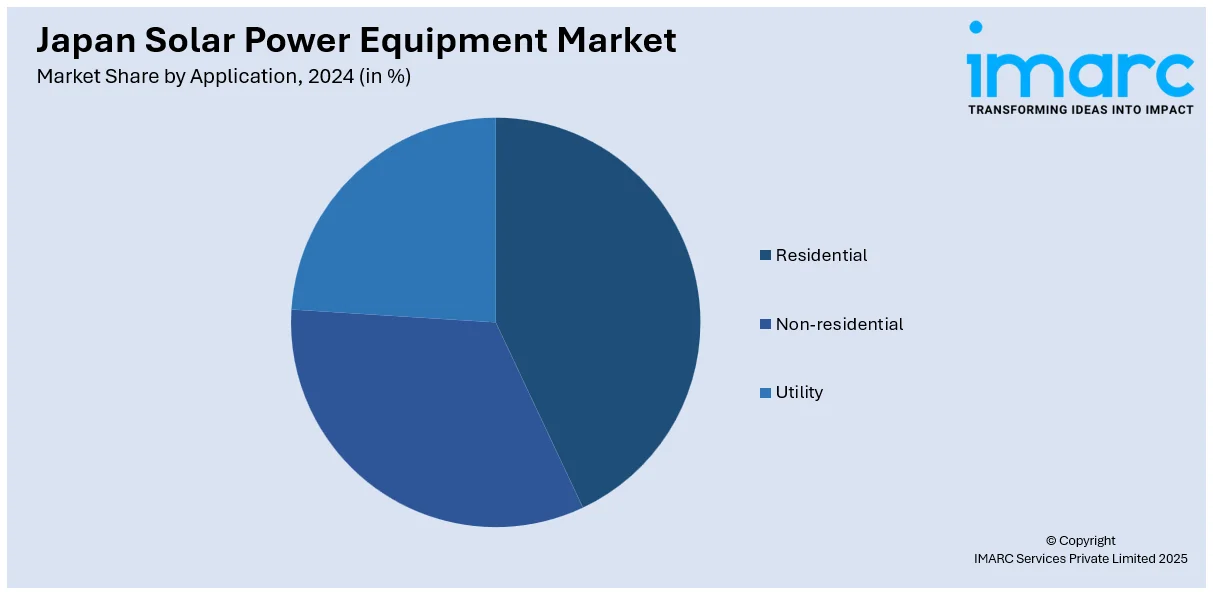
Japan Solar Power Equipment Market Size, Share, Trends and Forecast by Equipment, Application, and Region, 2025-2033
Japan Solar Power Equipment Market Overview:
The Japan solar power equipment market size reached USD 8.52 Billion in 2024. Looking forward, IMARC Group expects the market to reach USD 25.09 Billion by 2033, exhibiting a growth rate (CAGR) of 11.4% during 2025-2033. Government incentives for renewable energy, rising electricity demand, technological advancements in solar panel efficiency, growing environmental awareness, and the nation's commitment to reducing carbon emissions are some of the factors contributing to Japan solar power equipment market share.
|
Report Attribute
|
Key Statistics
|
|---|---|
|
Base Year
|
2024
|
|
Forecast Years
|
2025-2033
|
|
Historical Years
|
2019-2024
|
| Market Size in 2024 | USD 8.52 Billion |
| Market Forecast in 2033 | USD 25.09 Billion |
| Market Growth Rate 2025-2033 | 11.4% |
Japan Solar Power Equipment Market Trends:
Decreasing Costs Driving Growth in Concentrating Solar Power (CSP)
The significant reduction in the cost of concentrating solar power (CSP) is positively influencing Japan's solar power equipment market. As CSP technology becomes more affordable, it is expected to increase its adoption in the country, making it a more economically viable energy source. This shift is in line with Japan's growing focus on sustainable energy solutions. The lower costs associated with CSP will encourage greater investment in solar power infrastructure, supporting the nation’s efforts to diversify energy sources and enhance energy efficiency. With CSP becoming more accessible, Japan is poised to strengthen its renewable energy capacity and reduce its reliance on traditional energy sources. These factors are intensifying the Japan solar power equipment market growth. For example, in October 2024, the International Renewable Energy Agency (IRENA) reported a 70% decline in the global weighted average levelized cost of energy for CSP from 2010 to 2023. This trend is expected to benefit Japan's solar market by making CSP more economically viable.

Growth in High-Efficiency Solar Panels
The introduction of high-efficiency solar panels designed to maximize energy output while reducing installation costs is driving innovation in Japan's solar power equipment market. These advanced panels utilize cutting-edge technologies that improve solar energy utilization, addressing the rising demand for sustainable energy solutions. This development supports Japan's broader objectives of increasing solar capacity and transitioning to a low-carbon energy mix. As these efficient solar systems become more accessible, they contribute to enhancing energy independence and sustainability, offering cost-effective solutions for both residential and commercial solar installations. This shift is expected to accelerate the adoption of solar energy in Japan, further positioning the country as a leader in renewable energy innovation. For instance, in December 2024, Panasonic announced the launch of its high-efficiency HIT series solar panels in Japan, designed to enhance energy output while reducing installation costs. The new panels incorporate advanced technologies aimed at improving solar energy utilization, responding to Japan's increasing demand for sustainable energy solutions. This move aligns with the country's goals to expand its solar capacity and transition toward a low-carbon energy mix.
Japan Solar Power Equipment Market Segmentation:
IMARC Group provides an analysis of the key trends in each segment of the market, along with forecasts at the country and regional levels for 2025-2033. Our report has categorized the market based on equipment and application.
Equipment Insights:
- Solar Panels
- Mounting, Racking, and Tracking System
- Storage System
- Others
The report has provided a detailed breakup and analysis of the market based on the equipment. This includes solar panels, mounting, racking, and tracking system, storage system, and others.
Application Insights:

- Residential
- Non-residential
- Utility
A detailed breakup and analysis of the market based on the application have also been provided in the report. This includes residential, non-residential, and utility.
Regional Insights:
- Kanto Region
- Kansai/Kinki Region
- Central/Chubu Region
- Kyushu-Okinawa Region
- Tohoku Region
- Chugoku Region
- Hokkaido Region
- Shikoku Region
The report has also provided a comprehensive analysis of all the major regional markets, which include Kanto Region, Kansai/Kinki Region, Central/Chubu Region, Kyushu-Okinawa Region, Tohoku Region, Chugoku Region, Hokkaido Region, and Shikoku Region.
Competitive Landscape:
The market research report has also provided a comprehensive analysis of the competitive landscape. Competitive analysis such as market structure, key player positioning, top winning strategies, competitive dashboard, and company evaluation quadrant has been covered in the report. Also, detailed profiles of all major companies have been provided.
Japan Solar Power Equipment Market News:
- In April 2025, Enphase Energy entered the Japanese solar market with the launch of its IQ8 Microinverters. This product is designed to enhance solar energy systems' performance and efficiency, aligning with Japan's growing demand for high-quality solar solutions. Enphase’s entry underscores the expanding opportunities in Japan’s solar market, driven by a shift toward advanced, reliable solar equipment to meet the country's renewable energy goals.
- In February 2025, Japan announced a JPY 157 Billion subsidy for Sekisui Chemical to commercialize ultra-thin perovskite solar cells. These flexible panels aim to generate energy equivalent to 20 nuclear power plants by 2040, supporting the nation's renewable energy targets.
Japan Solar Power Equipment Market Report Coverage:
| Report Features | Details |
|---|---|
| Base Year of the Analysis | 2024 |
| Historical Period | 2019-2024 |
| Forecast Period | 2025-2033 |
| Units | Billion USD |
| Scope of the Report |
Exploration of Historical Trends and Market Outlook, Industry Catalysts and Challenges, Segment-Wise Historical and Future Market Assessment:
|
| Equipments Covered | Solar Panels, Mounting, Racking, and Tracking System, Storage System, Others |
| Applications Covered | Residential, Non-residential, Utility |
| Regions Covered | Kanto Region, Kansai/Kinki Region, Central/Chubu Region, Kyushu-Okinawa Region, Tohoku Region, Chugoku Region, Hokkaido Region, Shikoku Region |
| Customization Scope | 10% Free Customization |
| Post-Sale Analyst Support | 10-12 Weeks |
| Delivery Format | PDF and Excel through Email (We can also provide the editable version of the report in PPT/Word format on special request) |
Key Questions Answered in This Report:
- How has the Japan solar power equipment market performed so far and how will it perform in the coming years?
- What is the breakup of the Japan solar power equipment market on the basis of equipment?
- What is the breakup of the Japan solar power equipment market on the basis of application?
- What is the breakup of the Japan solar power equipment market on the basis of region?
- What are the various stages in the value chain of the Japan solar power equipment market?
- What are the key driving factors and challenges in the Japan solar power equipment?
- What is the structure of the Japan solar power equipment market and who are the key players?
- What is the degree of competition in the Japan solar power equipment market?
Key Benefits for Stakeholders:
- IMARC’s industry report offers a comprehensive quantitative analysis of various market segments, historical and current market trends, market forecasts, and dynamics of the Japan solar power equipment market from 2019-2033.
- The research report provides the latest information on the market drivers, challenges, and opportunities in the Japan solar power equipment market.
- Porter's five forces analysis assist stakeholders in assessing the impact of new entrants, competitive rivalry, supplier power, buyer power, and the threat of substitution. It helps stakeholders to analyze the level of competition within the Japan solar power equipment industry and its attractiveness.
- Competitive landscape allows stakeholders to understand their competitive environment and provides an insight into the current positions of key players in the market.
Need more help?
- Speak to our experienced analysts for insights on the current market scenarios.
- Include additional segments and countries to customize the report as per your requirement.
- Gain an unparalleled competitive advantage in your domain by understanding how to utilize the report and positively impacting your operations and revenue.
- For further assistance, please connect with our analysts.
 Request Customization
Request Customization
 Speak to an Analyst
Speak to an Analyst
 Request Brochure
Request Brochure
 Inquire Before Buying
Inquire Before Buying




.webp)




.webp)












